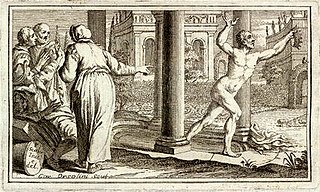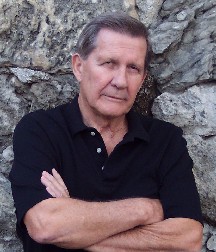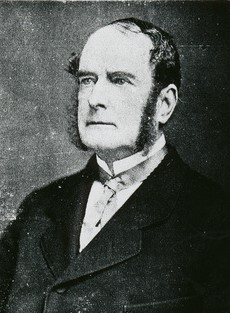Biography
Born April 23, 1816, in Charlottetown, Prince Edward Island, to an impoverished British lieutenant, it is believed Douglas Smith Huyghue was educated at the Saint John Grammar School. His first published poetry was in the Halifax Morning Post and Parliamentary Reporter, where his work appeared under the pseudonym 'Eugene'. [1] In the early 1840s, he began regularly contributing poetry, short fiction, and essays to the literary magazine Amaranth, published in Saint John, New Brunswick. His novel, Argimou: A Legend of the Micmac, was serialized in Amaranth in 1842 and was first published in book form in 1847. At that time Huyghue also assisted province’s commissioner of Indian affairs in arranging an exhibition of Indian artefacts. [2] In the late 1840s he moved to England, where he published a three-volume novel, Nomades of the West; or, Ellen Clayton (1850), and then immigrated to Australia on the Lady Peel in 1852. [3] In 1853 he became a clerk in the Office of Mines in the Ballarat goldfields, where he witnessed the Eureka Stockade revolt of 1854. His watercolor, "The Eureka Stockade," is exhibited at the Ballarat Fine Art Gallery. He continued working as a civil servant in Ballarat and Graytown, his last post being at the Department of Mines in Melbourne. He died July 24, 1891.

The Eureka Rebellion was a series of events involving gold miners who revolted against the British administration of the colony of Victoria, Australia during the Victorian gold rush. It culminated in the Battle of the Eureka Stockade, which took place on 3 December 1854 at Ballarat between the rebels and the colonial forces of Australia. The fighting left at least 27 dead and many injured, most of the casualties being rebels. There was a preceding period beginning in 1851 of peaceful demonstrations and civil disobedience on the Victorian goldfields. The miners had various grievances, chiefly the cost of mining permits and the officious way the system was enforced.
Matthew Joseph Bruccoli was an American professor of English at the University of South Carolina. He was the preeminent expert on F. Scott Fitzgerald. He also wrote about other writers, notably Ernest Hemingway, Thomas Wolfe and John O'Hara, and was editor of the Dictionary of Literary Biography.

The Eureka Flag was flown at the Battle of the Eureka Stockade, which took place on 3 December 1854 at Ballarat in Victoria, Australia. It was the culmination of the 1851–1854 Eureka Rebellion on the Victorian goldfields. Gold miners protested the cost of mining permits, the officious way the colonial authorities enforced the system, and other grievances. An estimated crowd of over 10,000 demonstrators swore allegiance to the flag as a symbol of defiance at Bakery Hill on 29 November 1854. It was then flown over the Eureka Stockade during the battle that resulted in at least 27 deaths. Around 120 miners were arrested, and many others were badly wounded.

Peter Fintan Lalor was an Irish-Australian rebel and, later, politician who rose to fame for his leading role in the Eureka Rebellion, an event identified with the "birth of democracy" in Australia.

Eureka is an interjection used to celebrate a discovery or invention. It is a transliteration of an exclamation attributed to Ancient Greek mathematician and inventor Archimedes.

Donn Pearce was an American author and journalist best known for the novel and screenplay Cool Hand Luke.

Charles Alphonse Doudiet was a Swiss-born Canadian artist and digger present at the Eureka Stockade, Ballarat, in the British Colony of Victoria, in 1854. His sketchbook, discovered by his descendants in 1996, has provided contemporary images of events connected to the Eureka Rebellion, that were important for the authentication of the original Eureka Flag.

Raffaello Carboni was an Italian writer, composer and interpreter who wrote a book on the Eureka Stockade which he witnessed while living in Australia. After periods of travelling, he returned to Italy where he died in Rome.

Eureka Stockade is a 1949 British film of the story surrounding Irish-Australian rebel and politician Peter Lalor and the gold miners' rebellion of 1854 at the Eureka Stockade in Ballarat, Victoria, in the Australian Western genre.

The Ballarat Reform League came into being in October 1853 and was officially constituted on 11 November 1854 at a mass meeting of miners in Ballarat, Victoria to protest against the Victorian government's mining policy and administration of the goldfields.

Evelyn Pitfield Shirley Sturt was born in Dorset, England. He was the youngest son of Thomas Lenox Napier Sturt, a puisne judge in Bengal for the British East India Company, and Jeanette or Jeannette, née Wilson. One of his older brothers was the Australian explorer Charles Sturt.

The Dictionary of Literary Biography is a specialist biographical dictionary dedicated to literature. Published by Gale, the 375-volume set covers a wide variety of literary topics, periods, and genres, with a focus on American and British literature.

Richard Bentley was a 19th-century English publisher born into a publishing family. He started a firm with his brother in 1819. Ten years later, he went into partnership with the publisher Henry Colburn. Although the business was often successful, publishing the famous "Standard Novels" series, they ended their partnership in acrimony three years later. Bentley continued alone profitably in the 1830s and early 1840s, establishing the well-known periodical Bentley's Miscellany. However, the periodical went into decline after its editor, Charles Dickens, left. Bentley's business started to falter after 1843 and he sold many of his copyrights. Only 15 years later did it begin to recover.

The Battle of the Eureka Stockade was fought in Ballarat, Victoria, on 3 December 1854, between gold miners and the colonial forces of Australia. It was the culmination of the 1851–1854 Eureka Rebellion during the Victorian gold rush. The fighting resulted in at least 27 deaths and many injuries, the majority of casualties being rebels. The miners had various grievances, chiefly the cost of mining permits and the officious way the system was enforced.
The following bibliography includes notable sources concerning the Eureka Rebellion. This article is currently being expanded and revised.

Edward Thonen was a German emigrant to Australia, and one of the miners involved in the Eureka Rebellion in Ballarat, Victoria. He was captain of one of the miners' divisions. When soldiers stormed the Stockade on 3 December 1854, Thonen was one of the first to be killed in the Battle of the Eureka Stockade.

The 1854 mining revolt in Australia, Eureka Rebellion inspired numerous novels, poems, films, songs, plays and artworks. Much of Eureka folklore relies heavily on Raffaello Carboni's 1855 book, The Eureka Stockade, which was the first and only comprehensive eyewitness account of the Eureka rebellion. The poet Henry Lawson wrote about Eureka, as have many novelists.

There were key people involved in the Eureka Rebellion who subscribed to the ideals of Chartism and saw the struggle on the Victorian goldfields as a continuation of the activism in Britain in the 1840s and "the centuries of heroic struggles in England which preceded the Australian Federation" such as the 1688 Glorious Revolution, that resulted in the enactment of the English Bill of Rights. From 1837 to 1848, 129,607 incomers to Australia arrived from the British mainland, with at least 80 "physical force" chartists sentenced to penal servitude in Van Diemens Land. Currey agrees that the population at the time would have been sufficiently politically awake such that: "it may be fairly assumed that the aims of the Anti-Corn-Law League and the Chartists were very familiar to many of the Victorian miners."

The Eureka Stockade was a crude battlement built and garrisoned by rebel gold miners at Ballarat in Australia during the Eureka Rebellion of 1854. It stood from 30 November until the Battle of the Eureka Stockade on 3 December. The exact dimensions and location of the stockade are a matter of debate among scholars. There are various contemporary representations of the Eureka Stockade, including the 1855 trial map and Eureka Slaughter by Charles Doudiet.

It is currently known that the Eureka rebels came from at least 23 different nations, including Australia, Canada, the United States of America, Jamaica, Mauritius, Russia, Norway, Finland, Sweden, Denmark, Poland, Switzerland, Italy, Greece, The Netherlands, Scotland, Ireland, England, Wales, Germany, France, Portugal and Spain. Raffaello Carboni recalled that "We were of all nations and colours." During the 1855 Victorian High Treason trials The Argus court reporter observed that of "the first batch of prisoners brought up for examination, the four examined consisted of one Englishman, one Dane, one Italian, and one negro, and if that is not a foreign collection, we do not know what is." However, according to Professor Anne Beggs-Sunter's figures, in her sample of 44 rebels, only one hailed from a non-European country.








